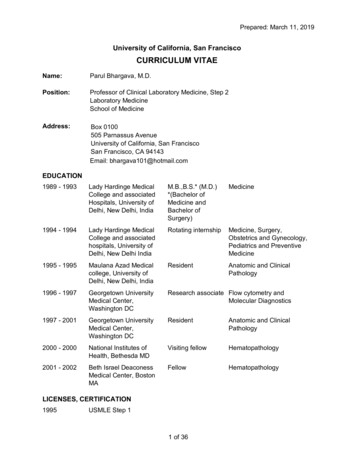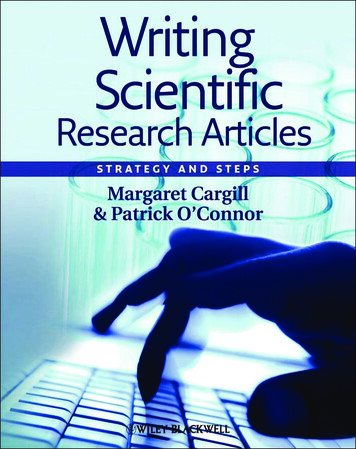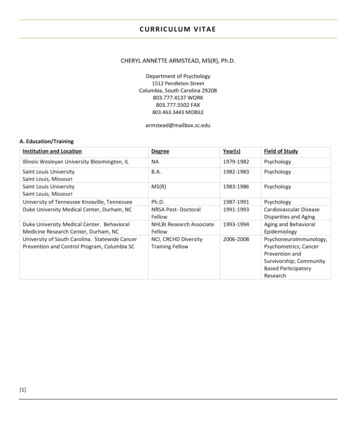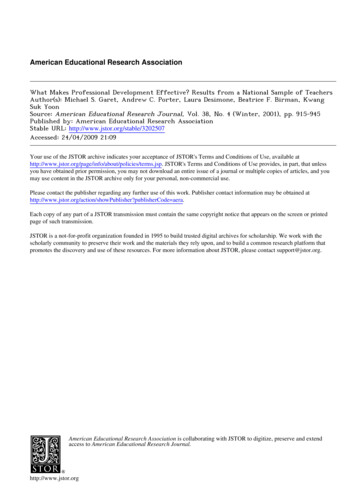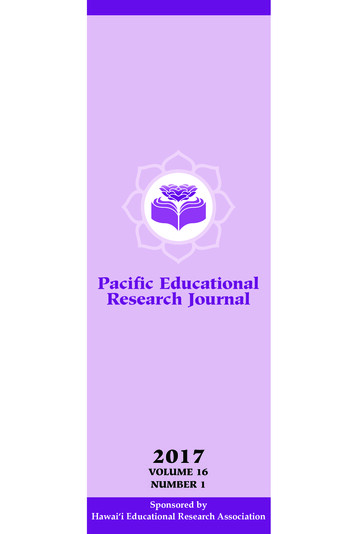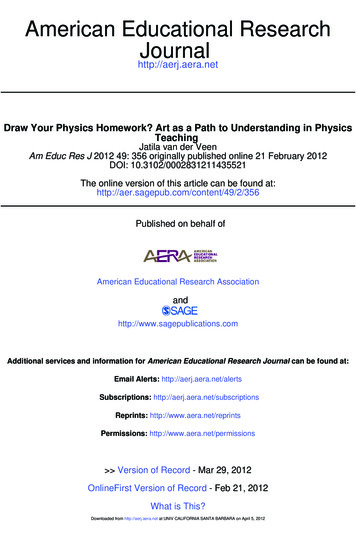
Transcription
American Educational ResearchJournalhttp://aerj.aera.netDraw Your Physics Homework? Art as a Path to Understanding in PhysicsTeachingJatila van der VeenAm Educ Res J 2012 49: 356 originally published online 21 February 2012DOI: 10.3102/0002831211435521The online version of this article can be found d on behalf ofAmerican Educational Research ional services and information for American Educational Research Journal can be found at:Email Alerts: http://aerj.aera.net/alertsSubscriptions: http://aerj.aera.net/subscriptionsReprints: http://www.aera.net/reprintsPermissions: http://www.aera.net/permissions Version of Record - Mar 29, 2012OnlineFirst Version of Record - Feb 21, 2012What is This?Downloaded from http://aerj.aera.net at UNIV CALIFORNIA SANTA BARBARA on April 5, 2012
American Educational Research JournalApril 2012, Vol. 49, No. 2, pp. 356–407DOI: 10.3102/0002831211435521Ó 2012 AERA. http://aerj.aera.netDraw Your Physics Homework?Art as a Path to Understanding in PhysicsTeachingJatila van der VeenUniversity of California, Santa BarbaraThe persistent fear of physics by learners motivated the author to take actionto increase all students’ interest in the subject via a new curriculum forintroductory college physics that applies Greene’s model of AestheticEducation to the study of contemporary physics, utilizing symmetry as themathematical foundation of physics as well as the conceptual link betweenphysics and the arts. The author describes the curriculum and suggestshow students’ drawings and written commentaries can provide insightsinto students’ preferred learning modalities, promote understanding ofabstract concepts through visualization, and reveal students’ preexisting attitudes toward science. Outcomes align with the goals of improving students’attitudes toward physics, indicated by their comments, written work, and results of the Maryland Physics Expectations Survey.KEYWORDS: physics education, aesthetic education, interdisciplinary education, arts-integration, symmetry, contemporary physicsIn spite of government initiatives to attract a more diverse population ofstudents into science and technology, research conducted by theAmerican Institute of Physics (AIP) suggests that although the percentagesare up from the 0% to 3% range in 1958 (the first year that such data werecollected), there is still a dearth of women and minorities in physics andengineering in the United States (AIP Statistical Research Center, n.d.-a,n.d.-b; Ivy & Ray, 2005). In 2008, 17% of all physics PhDs in the UnitedJATILA VAN DER VEEN is a visiting researcher in the Department of Physics and lecturer inthe College of Creative Studies at the University of California Santa Barbara, SantaBarbara, CA 93107; e-mail: jatila@physics.ucsb.edu. She is also serving as the education and public outreach lead for the NASA collaborators on the international PlanckMission, a satellite that is measuring the cosmic microwave background radiation ofthe universe with unprecedented detail. Her current research focuses on the applications of interdisciplinary strategies and media-arts technology in physics and astronomy education.Downloaded from http://aerj.aera.net at UNIV CALIFORNIA SANTA BARBARA on April 5, 2012
Art as a Path to Understanding in Physics TeachingStates were awarded to women while 83% went to men (AIP StatisticalResearch Center, n.d.-b). When the numbers of PhDs in physics in theUnited States in 2008 are broken down by race and ethnicity, only 1% wereawarded to Hispanic Americans, 1% to African Americans, while 41% wentto White Americans and 54% to foreign nationals (AIP Statistical ResearchCenter, n.d.-a). Hazari, Sonnert, Sadler, and Shanahan (2010) cite recent studies that show that physics lags behind biology and other sciences in awardingbachelor’s degrees to women, so that the relative number of female studentsgraduating with degrees in physics has actually declined in proportion to thenumber of women in other sciences. In addition to the persistent lack offemale and minority students, they also note a decline in the total numberof degrees (to men and women) awarded in physics between 1983 and2005 relative to other sciences, indicating general lack of interest in studyingphysics among all students. It behooves us to ask: Why should this be so?Negative popular opinions of physics appear to have been woven intoour Western culture for some time. In an article in the journal PhysicsEducation in 1976, physicist Victor Weisskopf wrote, ‘‘Why is physics as a science considered ‘inhuman’ by so many people, including some of the students we teach?’’ (Weisskopf, 1976, p. 75). A generation later, a quotefrom an interview with a female sculpture major at a California university indicates that students’ perceptions of physics may have not changed muchover the years:Children grow up learning that science is scary and—especially physicsand math. Somehow, chemistry doesn’t have that big of a stigma, butphysics and math—it’s like, Oooo, Scary. . . . I think there’s just something that is DONE in the way that it is arranged or taught that makespeople really AFRAID of it, and I think it is taught in a way that iskind of—seems very EXCLUSIVE. And I ALWAYS had that feeling aboutphysics, I always had the feeling that scientists are exclusive . . . so, ifthere’s some way to kind of . . . make it a little less . . .FRIGHTENING, I don’t know how, though. (van der Veen, 2007)The Possible Role of the Introductory Physics Sequencein Maintaining the Status QuoThe standard introductory physics course begins with Newtonianmechanics, in a curriculum that was established in the 1950s in responseto the Western world’s race for space (Brekke, 1995; Stuver, 2001).Osborne (1990) suggested that although Newton’s contributions were certainly revolutionary for his time, they represent a world view that is ‘‘relentlessly deterministic, linear and remote from human action or influence.’’ Hefurther suggested that the complete overrepresentation of Newtonian physics at the expense of contemporary physics presents a distorted view of theworld, which fails to address what should be the goals of contemporary357Downloaded from http://aerj.aera.net at UNIV CALIFORNIA SANTA BARBARA on April 5, 2012
van der Veenphysics education: ontology—what is the nature of reality and how did theuniverse come to be?; and epistemology—how do we know that which weclaim to know? Recent studies suggest that the way physics is taught tobeginning students may play a nontrivial role in both the persistent genderbias as well as the declining interest in studying physics among college students. Blickenstaff (2005) examined 30 years of research on the genderimbalance in physics in the United States and concluded that the very natureof science may be a significant contributor to what has been called the‘‘leaky pipeline,’’ whereby women have greater attrition rates than men inphysics. In a study of nearly 4,000 students from 34 randomly selectedAmerican colleges and universities, a lack of self-identification with physicswas one of the most potent deterrents to studying physics, particularly forgirls (Hazari et al., 2010).The ongoing Relevance of Science Education (ROSE) project in Europefinds similarly negative attitudes toward school science among 15-year-oldpupils in Northern Europe and the United Kingdom (Sjøberg & Schreiner,2010), and towards physics in particular (Kessels, Rau, & Hannover, 2006).After surveying adolescents in this age group in 34 countries in Europe,Africa, and the Pacific Islands about their attitudes toward science and technology, Schreiner and Sjøberg (2005) suggest that the perception of scienceas taught in schools may not be compatible with youth culture identity incontemporary Western societies and that perhaps young people perceivethe identity of an engineer or a physicist as ‘‘incongruent with their own’’(p. 13). Their survey also suggested that boys prefer topics such as explosives and machines, which figure prominently in the introductory physicscurriculum with its heavy emphasis on Newtonian mechanics, while girlsprefer topics relating to biology, health, ethical, aesthetic, and ‘‘New Age’’concerns (Sjøberg & Schreiner, 2007).In a preliminary study (not yet published) I interviewed second gradersin a public school in Santa Barbara, California, after they attended a physicsdemonstration show put on by students from the local university. I foundthat girls and boys were equally interested in the demonstrations, butwhen asked what they want to be when they grow up, the majority ofboys responded with occupations that deal with adventure and high risk(e.g., swat team, fire fighter, super hero), while the girls responded witha wide range of occupations that included medicine, education, entertainment, and the arts. Introductory physics, with its emphasis on Newtonianmechanics, relies heavily on scenarios involving projectiles, collisions, explosions, sports, machines, and military applications, which correlate withthe adventure and high-risk occupations chosen by the boys I interviewed.Recent research suggests that topics from contemporary physics areequally of interest to girls and boys and thus may provide a more genderneutral entry point for introductory physics. Sjøberg and Schreiner (2007)noted that both girls and boys reported equally high interest in studying358Downloaded from http://aerj.aera.net at UNIV CALIFORNIA SANTA BARBARA on April 5, 2012
Art as a Path to Understanding in Physics Teachingtopics from contemporary physics, including black holes, space science,unsolved mysteries in outer space, philosophical issues, and phenomenathat scientists still cannot explain. Angell, Guttersrud, Henriksen, and Isnes(2004) reported that unlike the topics from standard school science, adolescents have the sense that topics from contemporary physics relate to theirown interests and personal lives.These findings lead me to suggest that it is time to change the way inwhich we introduce physics to beginning students if we are truly interestedin promoting at least a more equitable gender balance in the physics community in future generations.Aesthetic Physics Education: A New Approach toIntroductory College PhysicsThey said, ‘‘You have a blue guitar,You do not play things as they are.’’—Wallace Stevens (1982) as quoted by Greene (2001)In an editorial in 2006 in Physics Today, the monthly news-and-opinionpublication of the American Institute of Physics, anthropologist Sheila Tobiassuggests that equal access to physics may be achieved through a new pedagogical paradigm, within which teachers can recognize a talent for physicsthat is ‘‘differently packaged from the norm’’ (p. 10). In another editorial inthe same journal, physicist Kent Eschenberg (2006), quoting a 1985 study ofscientists and artists by psychologist Robert Root-Bernstein, correlates the‘‘ability to imagine new realities,’’ which is the basis for new discoveries inscience, with ‘‘what are traditionally thought to be nonscientific skills . . .usually associated with the arts, music, and literature’’ (p. 10). With thesecomments in mind, and the sense that physics—a profoundly creative endeavor—is still perceived as inaccessible by so many, the following questionmotivated this study: How can we bring the values of aesthetics and creativity, which are important in the practice of physics, into the teaching andlearning of physics at the introductory college level without sacrificing theconceptual rigor that is necessary for proper understanding of the practiceof physics? In other words, how can we humanize the teaching and learningof physics so as to make physics accessible in the broadest sense, withoutlosing the qualities of honesty, objectivity, and repeatability, expressedthrough the language of mathematics, that define physics as a way of knowing and seeing?Maxine Greene’s Aesthetic Education provides the philosophical framework for a new pedagogical paradigm for introductory college physics that, Isuggest, has the potential to attract students who are ‘‘differently packagedfrom the norm.’’ In Variations on a Blue Guitar, Greene (2001) defines359Downloaded from http://aerj.aera.net at UNIV CALIFORNIA SANTA BARBARA on April 5, 2012
van der Veenaesthetics as ‘‘the way in which a work of art can become an object of experience, and the effect it then has in altering perspectives on nature, humanbeings, and moment-to moment existence’’ (p. 5). She describes educationas a ‘‘process of enabling persons to become different’’ by which ‘‘the learnermust break with the taken-for-granted, . . . and look through the lenses ofvarious ways of knowing, seeing, and feeling in a conscious endeavor toimpose different orders upon experience’’ (p. 5). For Greene, educationshould be ‘‘an initiation into new ways of seeing, hearing, feeling, moving’’and should ‘‘nurture a special kind of reflectiveness and expressiveness,a reaching out for meanings, a learning to learn’’ (p. 7). Unfortunately, formany students, their experience with introductory college physics leavesa permanent sense of frustration (Mazur, 1997).Greene (2001) proposed a set of Capacities for Aesthetic Learning as thedesired outcomes of Aesthetic Education: Noticing Deeply, Embodying,Questioning, Identifying Patterns, Making Connections, ExhibitingEmpathy, Creating Meaning, Taking Action, Reflecting and Assessing(Holzer, 2005). I suggest that the first five Capacities (Noticing Deeply,Embodying, Questioning, Identifying Patterns, and Making Connections)are, in essence, nondifferent from the goals of any introductory physicscourse, since physics represents a new way of seeing the world and requiresstudents to develop a new vocabulary with which to interpret experience. Isuggest that the next four Capacities (Exhibiting Empathy, Creating Meaning,Taking Action, and Reflecting and Assessing), goals of contemporary education that seeks to promote a sense of social justice, should also be goals ofcontemporary physics education if we as a community of physics educatorsare to redress the problems of equity, diversity, and the sense that physics is‘‘scary’’ and ‘‘inhuman.’’Aesthetics is not part of the lexicon of physics education, yet physics as itis practiced by professionals does seem to be motivated by a certain sense ofaesthetics. Nobel Laureate Steven Weinberg (1992) asserts:In this century, as we have seen in the cases of General Relativity andthe electroweak theory, the consensus in favor of physical theorieshas often been reached on the basis of aesthetic judgments beforethe experimental evidence for these theories became really compelling. I see in this the remarkable power of the physicist’s sense ofbeauty acting in conjunction with, and sometimes even in oppositionto, the weight of experimental evidence. (p. 130)I suggest that an introductory college course that incorporates learningstrategies from the arts into the teaching of physics, and which beginswith the 20th-century world view and later addresses Newtonian mechanics,may be effective in attracting a more diverse population of students than thepresent curriculum.360Downloaded from http://aerj.aera.net at UNIV CALIFORNIA SANTA BARBARA on April 5, 2012
Art as a Path to Understanding in Physics TeachingAbout This StudyThis article reports on the preliminary results of teaching an experimental college-level curriculum in Aesthetic Physics Education. This study beganas a dissertation project in the fall of 2006. The initial experiment was conducted during the winter quarter (January through March) of 2007 at theUniversity of California Santa Barbara (UCSB), a public university inCalifornia, and reported in van der Veen (2007). I had the enthusiastic cooperation of the dean of the College of Creative Studies (CCS), a small honorscollege within the larger university, to experiment on his students, as CCSencourages faculty to develop interdisciplinary, experimental courses. Mycourse, Symmetry and Aesthetics in Contemporary Physics, which I firsttaught in 2007, received such high evaluations from the students that Ihave been invited to teach it each year. I have taught it again in 2008,2010, and 2011, with a hiatus in 2009 while I was teaching out of state. Inthe second section I briefly describe the rationale for a symmetry-basedphysics curriculum and the theoretical frameworks that support the ideathat Aesthetic Physics Education has the potential to promote greater accessto physics and cite previous studies that support the use of arts in promotingaccess to physics, math, and engineering education. In the third section, Ibriefly describe the curriculum and the demographics of the students. Inthe fourth section, I discuss an application of drawing for understandingin physics and how students’ drawings, in conjunction with their writtenwork, can give insight into their preferred learning modalities, their attitudestoward physics and physicists, as well as their understanding of a readingassignment. I follow several students’ progressions through the course, asdemonstrated by some of their other writings and physics-art projects, whichindicate their various transformations in attitudes and conceptual understanding. In the fifth section, I suggest further research that would buildon these preliminary results and discuss possible implications of AestheticPhysics Education for increasing diversity in physics.Theoretical FrameworksThe conceptual framework for a symmetry-based introductory physicscurriculum was primarily inspired by Lawrence Krauss’s (1993/2007) bookFear of Physics and by Anthony Zee’s (1999/2007) Fearful Symmetry.Lengthy discussions with Professors Krauss and Zee (both theoretical physicists), as well as e-mail conversations with Professor Christopher Hill of theFermi National Accelerator Laboratory (Fermilab), helped clarify some of theteaching strategies. Critical discussions with Professor David Gross, NobelLaureate and director of the Kavli Institute for Theoretical Physics (KITP)at the University of California Santa Barbara, provided additional strategiesfor tying together topics in physics with the thread of symmetry.361Downloaded from http://aerj.aera.net at UNIV CALIFORNIA SANTA BARBARA on April 5, 2012
van der VeenThe pedagogical model that informed the design of this curriculum isGreene’s (2001) model of Aesthetic Education, as discussed in the previoussection. Support for Aesthetic Education as an educational paradigm that hasthe potential to increase access to physics can be found by combining thefollowing models: Multiple Worlds Theory (Phelan, Davidson, & Yu,1993), which illuminates the difficulties that minority students face when attempting to navigate the boundaries and borders that separate their homeworlds from the world of the dominant culture in public schools; sociolinguistic theories of language and power (Bourdieu, 1977); studies that suggest that the discourse of physics, which includes the language ofmathematics, serves to set physicists apart from everyday interactions(Bazerman, 2000, among others); and the historic importance of visualization in discoveries in physics (Holton, 1996; John-Steiner, 1997; Miller, 1989).Aesthetic Education as a Means of Reducing the BarriersPresented by the Discourse of PhysicsI suggest that incorporating teaching strategies from Aesthetic Educationin introductory college physics can assist students in overcoming some of thedifficulties of entry into physics that are associated with the way physicistsuse language. The discourse of science presents borders that separate science, particularly physics, as a speech community (Gumperz, 1968) by virtueof its specialized language. The discourse of physics, which includes the language of mathematics, sets physicists apart as a privileged group (Traweek,1988), which often leads to a general mistrust of physicists (Bazerman, 2000),yet, in order to understand physics, students must first learn to use languagein the way physicists do (Hestenes, 1998; May & Etkina, 2002). This languagebarrier can be especially problematic for minority culture students(Aikenhead, 2002; Brown, Kloser, & Henderson, 2010; Lee, 2003; Phelanet al., 1993).According to the Multiple Worlds Theory of Phelan et al. (1993), studentsfrom minority culture home worlds must make a transition to the dominantculture of the school world, with language being one of the barriers. Corson(2001) discussed the use of ‘‘high status vocabulary’’ as being problematic forminority culture students in dominant culture schools and recommendedthat managing discourses in school can be a powerful means of amelioratinginequalities. I suggest that the dominant position of sciences over arts in education resembles the hegemonic positioning of majority and minority culturestudents as described by Phelan et al.Eisner (2002) describes the origins of the cultural dominance of scienceover the arts as arising from the Enlightenment period in Western society,which was heavily influenced by the emergence of Newtonian physics:362Downloaded from http://aerj.aera.net at UNIV CALIFORNIA SANTA BARBARA on April 5, 2012
Art as a Path to Understanding in Physics TeachingScience was considered dependable; the artistic process was not.Science was cognitive; the arts were emotional. Science was teachable; the arts required talent. Science was testable; the arts were matters of preference. Science was useful; the arts were ornamental. Itwas clear to many then, as it is to many today, which side of thecoin mattered. (Eisner, 2002, p. 6)I have observed, over the 4 years I have been teaching this course in aninterdisciplinary setting, that even in a culturally homogeneous group of academically high status students, the same difficulties with language exist forarts-oriented students relative to physics as exist for minority culture studentsin a majority culture school relative to dominant culture discourse (van derVeen, 2007). I suggest that incorporating arts-based learning strategies ofAesthetic Education can help reduce barriers presented by language. Asone of the art students in the course, a White female, said in a post-courseinterview:[At first] I didn’t have the background to understand what we werediscussing or what we were looking at. I didn’t understand the wordswe were using, the language that we were using, was such an issuefor me. Taking the class has opened the way I perceive my world . . .because my perception of my existence and of the world is different.(Female art major, 2007)Aesthetic Education as a Means of Facilitating the Language of MathI suggest that the incorporation of cognitive strategies and ways ofknowing from the arts in concept development in physics can help studentslearn how to visualize the relationships that are described by the unfamiliarlanguage of mathematics. Hickman and Huckstep (2003) compared math toa language, in that once taught the rules of grammar, a student should beable to extract meaning from symbolic sentences (equations) and constructhis or her own syntactically correct sentences, follow logical arguments, andapply descriptors to new situations. Mathematics in physics education can becompared to Bourdieu’s langue in the sense that facility with math-as-alanguage represents not only linguistic competence in physics but also represents the symbolic capital that defines a student’s position within the socialhierarchy of a physics class. According to Bourdieu (1977), ‘‘All particularlinguistic transactions depend on the structure of the linguistic field, whichis itself a particular expression of the structure of the power relationsbetween the groups possessing the corresponding competences’’ (p. 4).The hegemony of math-speakers and non–math-speakers emerged insome of the remarks of my students in their essays:363Downloaded from http://aerj.aera.net at UNIV CALIFORNIA SANTA BARBARA on April 5, 2012
van der VeenPhysics major (male): When you get down to pure mathematics, such as abstractalgebra and number theory, there is nothing but art . . . reading a book on a subjectlike real analysis is like going to an art museum.Art major (female): I cannot speak about the greater concept of mathematics as Ihave no real knowledge about the subjects, however in relation to the goldenratio I believe that there is a simple yet unsettling beauty which enables the formsit creates to be interesting and intriguing.Art major (female): Not knowing how the other half lives makes physics seeminaccessible to the commoner, which is not necessarily true.The potential of incorporating learning strategies from AestheticEducation for changing these attitudes is suggested by some of the final comments of the students. The art major quoted previously commented in herfinal essay:The creation of the final project was important for me to be able todigest many of the concepts that we discussed in class. It gave methe ability to develop an understanding and a personal reference toconcepts that I found challenging. This was an invaluable part ofmy study of physics and I greatly appreciated the opportunity to learnin an integrated manner.Equations represent rich and sophisticated schema that a student can recallto give almost instantaneous access to a complex concept. A schema, defined as‘‘a cognitive construct that permits us to treat multiple elements of informationas a single element, categorized according to the manner in which it will beused’’ (Sweller, 1999, p. 10), can be anything from an apple to Faraday’s electricfield lines to Einstein’s field equations. Thus, the languages of the arts can provide a means of helping students visualize the relationships in the physicalworld that are described by mathematics. As one art major (White female, thirdyear) wrote in one of her weekly reading reflections,Perhaps anyone who is interested in physics should first undergoa basic math training so that equations make sense, and also a ‘‘language course.’’ In this course, students would be taught metaphorswith which they can understand and remember what terms like ‘‘avolt’’ or ‘‘symmetry’’ actually mean. But it is not a description that ismemorized for each term, but a picture.The Importance of Visualization in Physics EducationPhysics addresses phenomena that span a range of 40 orders of magnitude in scale, only a tiny fraction of which are directly accessible to our sensory perception. The rest must be imagined through symbolicrepresentations: equations, images, and specialized language. Visualizationhas been seminal in the development of Western science, and mathematics364Downloaded from http://aerj.aera.net at UNIV CALIFORNIA SANTA BARBARA on April 5, 2012
Art as a Path to Understanding in Physics Teachingprovides a powerful nonverbal language that allows us to visualize phenomena in the physical universe that we cannot experience directly. BrunoLatour’s (2002) evaluation that science is not about making ‘‘words correspond to worlds’’ but about ‘‘building reference chains through a cascadeof transformations from matter to form’’ is certainly applicable to the wayphysics is practiced today.A useful concept in physics teaching, which was first developed by 19thcentury Swiss educator Johann Heinrich Pestalozzi (1746–1827), isAnschauung: mental imagery developed by abstraction from phenomenathat have been directly experienced (Miller, 1989; Pestalozzi, 1805/1894).According to Pestalozzi, understanding is built on making sense of the‘‘sea of confused sense impressions, flowing one into the other,’’ and it isthe ‘‘business of instruction to remove the confusion of these sense impressions’’ (Pestalozzi, 1805/1894, p. 85). In other words, knowledge evolvesfrom confusion to definiteness, from definiteness to plainness, and fromplainness to clarity (Pestalozzi, 1805/1894). Pestalozzi advocated a threefoldsystem of interrogating the world: visualization, numeration, and description, or what he called form, number, and language. For successful education, these three aspects of making sense and creating meaning out of thephysical world cannot be separated (Pestalozzi, 1805/1894). Einstein himselfwas trained in this method of Anschauung in high school at theKantonsschule at Arrau (Miller, 1989), and Pestalozzi’s influence is evidentin his description of the nature of science in his 1936 (2003) essay‘‘Physics and Reality,’’ which I have students read and draw for the firsthomework assignment.Drawing as a Means of Concept Development in PhysicsDrawing is a means by which a learner (artist) can get in touch with andexpress her or his own inner language, and is thus a way to connect students’ internal translations of external experiences through symbolic representations. Although most of the research on the use of drawing forunderstanding has focused on primary education, I suggest that the use ofdrawing for understanding is entirely appropriate for introductory collegestudents, who may harbor completely naı̈ve interpretations of concepts inphysics based on prior assumptions, misunderstanding of texts, or simplya lack of previous exposure to physics.Several studies reported by Rinne, Gregory, Yarmolinskaya, andHardiman (2011) suggest that the use of arts as a teaching methodology leverages a number of factors that promote comprehension and long-termmemory. Edens and Potter (2003) demonstrate that students who were giventhe opportunity to draw their understanding of concepts related to the principle of Conservation of Energy, concurrently with verbal descriptions, performed better on tests than students who were given only verbal365Downloaded from http://aerj.aera.net at UNIV CALIFORNIA SANTA BARBARA on April 5, 2012
van der Veendescriptions. Based on the results of their study and others, they suggest that‘‘visual-based instructional strategies may be particula
n.d.-b; Ivy & Ray, 2005). In 2008, 17% of all physics PhDs in the United JATILA VAN DER VEEN is a visiting researcher in the Department of Physics and lecturer in the College of Creative Studies at the University of California Santa Barbara, Santa Barbara, CA 93107; e-mail: jatila@physics.ucsb.edu. She is also serving as the educa-





